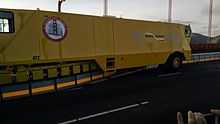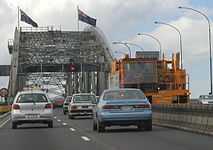Barrier transfer machine

Barrier transfer machines, also known as zipper machines, are heavy vehicles used to transfer concrete lane dividers, which are used to relieve traffic congestion during rush hours.

The vehicle contains an S-shaped channel in its undercarriage which lifts the barrier segments (which may weigh over one thousand pounds (454 kg)) off the road surface and transfers them over to the other side of the lane, reallocating traffic lanes to accommodate increased traffic for the currently dominant (tidal) direction. These barriers are linked together with steel connectors to create a formidable but flexible safety barrier.
Moveable barriers are in permanent use in such cities as Auckland (Auckland Harbour Bridge); Montreal, Canada; Philadelphia, Pennsylvania; New York (notably the Tappan Zee Bridge); Honolulu, Hawaii; San Juan, Puerto Rico; Boston, Massachusetts (for the Southeast Expressway); Washington, D.C.; Dallas, Texas; San Francisco (on the Golden Gate Bridge and Presidio Parkway); San Diego, California; and Sydney, Australia; many other cities use them temporarily during construction work.
A variant of the machine uses two narrower machines running in tandem. This setup tends to be used in reversible lanes when the movable barrier is used to divide two directions of traffic—the narrower machines are less of an impediment to traffic in either direction, also known as contra flow lanes. The lanes created by the machine are sometimes referred to as zipper lanes.
-

This giant machine was used (before replacement with a newer version) to pick up barriers to swap northbound and southbound lanes on the Auckland Harbour Bridge.
-

This large machine was used on the Auckland Harbour Bridge to shift the centre lane back and forth to accommodate rush hour traffic.
See also
References
- ↑ "Moveable Concrete Barrier" (PDF). p. 7. Retrieved 16 August 2014.